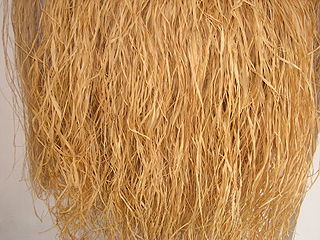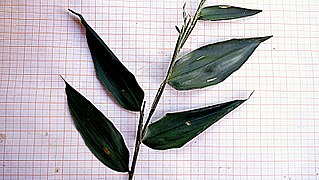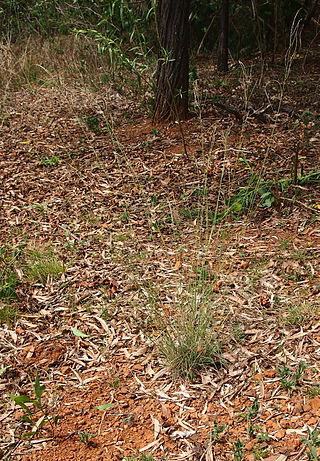
Arrhenatherum, commonly called oatgrass or button-grass, is a genus of Eurasian and North African plants in the grass family.

Echinochloa is a very widespread genus of plants in the grass family and tribe Paniceae. Some of the species are known by the common names barnyard grass or cockspur grass.

Brachyelytrum is a genus of North American and East Asian plants in the grass family, classified in its own tribe Brachyelytreae.

Raphia vinifera, the West African piassava palm, bamboo palm or West African bass fibre is a palm tree species in the genus Raphia. It is native to Benin, Gambia, Ghana, Nigeria, Togo, Central African Republic, Cameroon, Ghana, and Democratic Republic of the Congo. It is particularly abundant along the creeks of Niger Delta, Cross River, Lagos and Ikorodu in Nigeria.

Setaria is a widespread genus of plants in the grass family. The name is derived from the Latin word seta, meaning "bristle" or "hair", which refers to the bristly spikelets.

Enneapogon is a cosmopolitan genus of plants in the grass family.
Eriochrysis is a genus of African and Neotropical plants in the grass family.

Lithachne is a genus of Neotropical plants in the grass family.
- Lithachne horizontalisChase - Minas Gerais, Rio de Janeiro, São Paulo, Mato Grosso
- Lithachne humilisSoderstr. - Honduras
- Lithachne pauciflora(Sw.) P.Beauv. - widespread from Jalisco to Paraguay
- Lithachne pinetii(C.Wright) Chase - Cuba

Streptogyna is a widespread genus of tropical plants in the grass family. It is the only genus in the monotypic tribe Streptogyneae.

Diarrhena, or beakgrain, is a genus of Asian and North American plants in the grass family.

Elytrophorus is a genus of Asian, African, and Australian plants in the grass family.
Gymnopogon (skeletongrass) is a genus of American and Southeast Asian plants in the grass family.

Ichnanthus, commonly called bedgrass, is a genus of tropical plants in the grass family, widespread in Africa, Asia, Australia, and the Americas.

Leptochloa is a widespread genus of Asian, African, Australian, and American plants in the grass family.
Megastachya is a genus of African plants in the grass family.

Oplismenus hirtellus, commonly known as basket grass, is a species of flowering perennial plant from the family Poaceae that can be found on every continent in the world except Antarctica, growing mostly in coastal tropic and subtropic regions as well as tropical and subtropical islands such as Hawaii, New Zealand, Australia and Madagascar.

Oplismenus compositus, the running mountaingrass, is a species of perennial plant from the family Poaceae that can be found throughout Asia, Africa, Australia, South America, Mexico and Hawaii.

Oplismenus undulatifolius, commonly known as wavyleaf basketgrass, is a species of perennial grass from the family Poaceae that is native to Eurasia, specifically Southern Europe through Southern Asia. Due to its invasive nature, it can be found in countries such as Pakistan, China, Japan, Korea, India, Australia, South Africa, and has since been introduced to the Mid-Atlantic United States. There are no recognized subspecies in Catalogue of Life.

Paniceae is a large tribe of the subfamily Panicoideae in the grasses (Poaceae), the only in the monotypic supertribe Panicodae. It includes roughly 1,500 species in 84 genera, primarily found in tropical and subtropical regions of the world. Paniceae includes species using either of the C4 and C3 photosynthetic pathways, as well as presumably intermediate species. Most of the millets are members of tribe Paniceae.

Paractaenum novae-hollandiae is a grass, native to Western Australia. It is an annual herb growing from 0.2 to 0.5 m high, on sands and loams. Its green-purple flowers may be seen from March to September.



















